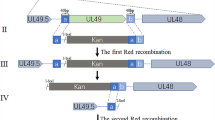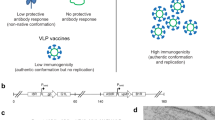Abstract
The viral protein 22 (VP22) in the tegument of Marek’s disease virus serotype 1 (MDV-1) plays an important role in cell-to-cell spread and viral propagation. Antiserum against the carboxyl terminus of VP22 was prepared by immunizing mice with recombinant VP22 expressed in E. coli, and used to investigate its expression in chicken embryo fibroblast (CEF) cells infected with different MDV-1 strains. At an infection dose of PFU=50, intercellular trafficking of the VP22 into the nuclei of the surrounding receipt cells was detected as early as 3 hours post infection. By 6 hours after infection (before viral plague formation), the protein was detected in the whole nuclei of the recipient cells with no difference among MDV-1 strains CVI988/Rispens, GA and RB1B. Intra-nuclear accumulation of the VP22 protein was further increased when the viral plagues started to form. These results indicate that, albeit the existence of the 201TKSERT206 deletion, the VP22 of the CVI988/Rispens vaccine strain has also intercelular-trafficking function, which might serve as a potential alternative delivering protein instead of virulent strains VP22.
Similar content being viewed by others
References
Yanagida N, Yoshida S, Nazerian K, et al. Nucleotide and predicted amino acid sequences of Marek’s disease virus homologues of herpes simplex virus major tegument proteins. J Gen Virol, 1993, 74(9): 1837–1845
Elliott G D, Meredith D M. The herpes simplex virus type 1 tegument protein VP22 is encoded by gene UL49. J Gen Virol, 1992, 73(3): 723–726
Elliott G, O’Hare P. Intercellular trafficking and protein delivery by a herpesvirus structural protein. Cell, 1997, 88(2): 223–233
Saskia A R, Piter J B, Jennifer L R. Induction of insolubility by herpes simplex virus VP22 precludes intercellular trafficking of N-terminal Apoptin-VP22 fusion proteins. J Mol Med, 2003, 81: 558–565
Brewis N, Phelan A, Webb J, et al. Evaluation of VP22 spread in tissue culture. J Virol, 2000, 74(2): 1051–1056
Dorange F, Tischer B K, Vautherot J F, et al. Characterization of Marek’s disease virus serotype 1 (MDV-1) deletion mutants that lack UL46 to UL49 genes: MDV-1 UL49, encoding VP22, is indispenssable for virus growth. J Virol, 2002, 76(4): 1959–1970
Dorange F, Mehdaoui S, Pichon C, et al. Marek’s disease virus (MDV) homologues of herpes simplex virus type 1 UL49 (VP22) and UL48 (VP16) genes: high-level expression and characterization of MDV-1 VP22 and VP16. J Gen Virol, 2000, 81(9): 2219–2230
Hung C F, He L, Juang J, et al. Improving DNA vaccine potency by linking Marek’s disease virus type 1 VP22 to an antigen. J Virol, 2002, 76(6): 2676–2682
Chen H J, Qin A J, Ding C, et al. Difference in the VP22 gene between oncogenic and attenuated strains of Marek’s disease virus serotype 1. J Yangzhou Univ. (Agri & Life Sci edition) (in Chinese), 2003, 24(4): 8–11
Chen H J, Qin A J, Song C P, et al. Highly soluble expression of carboxyl terminus of MDV-1 VP22 in E coli. Virol Sinica (in Chinese), 2006, 21(2): 284–286
El-Andaloussi S, Holm T, Langel U. Cell-penetrating peptides: mechanisms and applications. Curr Pharm Des, 2005, 11(28): 3597–3611
Elliott G, O’Hare P. Intercellular trafficking of VP22-GFP fusion proteins. Gene Ther, 1999, 6(1): 149–151
Normand N, van Leeuwen H, O’Hare P. Particle formation by a conserved domain of the herpes simplex virus protein VP22 facilitating protein and nucleic acid delivery. J Biol Chem, 2001, 276(18): 15042–15050
Zheng C, Babiuk L A, van Drunen Littel-van den Hurk S. Bovine herpesvirus 1 VP22 enhances the efficacy of a DNA vaccine in cattle. J Virol, 2005, 79(3): 1948–1953
O’Donnell L A, Clemmer J A. Marek’s disease virus VP22: sub-cellular localization and characterization of carboxyl terminal deletion Mutations. Virology, 2002, 292(2): 235–240
Brian J G, Gina L C, John E T, et al. Herpes simplex virus 2 VP22 phosphorylation induced by cellular and viral kinases does not influence intracellular localization. Virology, 2004, 330: 74–81
del Rio T, Werner H C, Enquist L W. The pseudorabies virus VP22 homologue (UL49) is dispensable for virus growth in vitro and has no effect on virulence and neuronal spread in rodents. J Virol, 2002, 76(2): 774–782
Elliott G, O’Reilly D, O’Hare P. Phosphorylation of the herpes simplex virus type 1 tegument protein VP22. Virology, 1996, 226(1): 140–145
Elliott G, O’Hare P. Herpes simplex virus type 1 tegument protein VP22 induces the stabilization and hyperacetylation of microtubules. J Virol, 1998, 72(8): 6448–6455
Elliott G, O’Reilly D, O’Hare P. Identification of phosphorylation sites within the herpes simplex virus tegument protein VP22. J Virol, 1999, 73(7): 6203–6206
Pomeranz L E, Blaho J A. Modified VP22 Localizes to the Cell Nucleus during Synchronized Herpes Simplex Virus Type 1 Infection. J Virol, 1999, 73(8): 6769–6781
Morrison E E, Wang Y F, Meredith D M. Phosphorylation of structural components promotes dissociation of the herpes simplex virus type 1 tegument. J Virol, 1998, 72(9): 7108–7114
Elliott G, Mouzakitis G, O’Hare P. VP16 interacts via its activation domain with VP22, a tegument protein of herpes simplex virus, and is relocated to a novel macromolecular assembly in coexpressing cells. J Virol, 1995, 69(12): 7932–7941
Fuchs W, Klupp B G, Granzow H, et al. Physical interaction between envelope glycoproteins E and M of pseudorabies virus and the major tegument protein UL49. J Virol, 2002, 76(16): 8208–8217
Author information
Authors and Affiliations
Corresponding author
Additional information
Supported by the National Natural Science Foundation of China (Grant No. 30371070)
Rights and permissions
About this article
Cite this article
Chen, H., Song, C., Qin, A. et al. Expression and intercellular trafficking of the VP22 protein of CVI988/Rispens vaccine strain of Marek’s disease virus. SCI CHINA SER C 50, 75–79 (2007). https://doi.org/10.1007/s11427-007-2038-1
Received:
Accepted:
Issue Date:
DOI: https://doi.org/10.1007/s11427-007-2038-1




